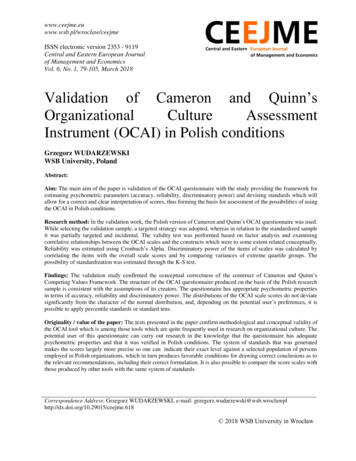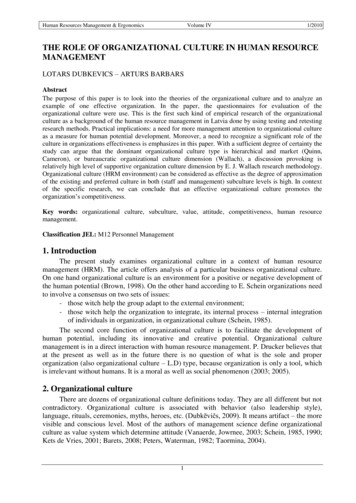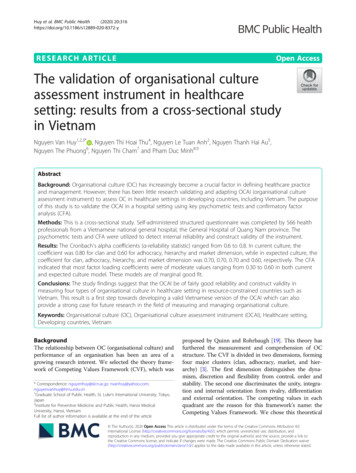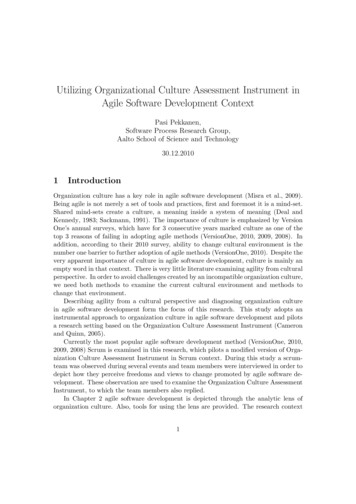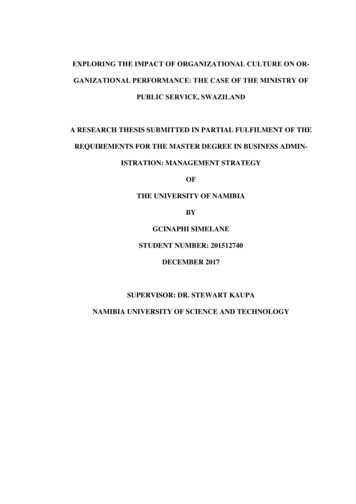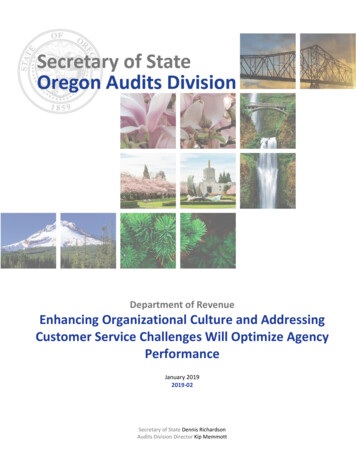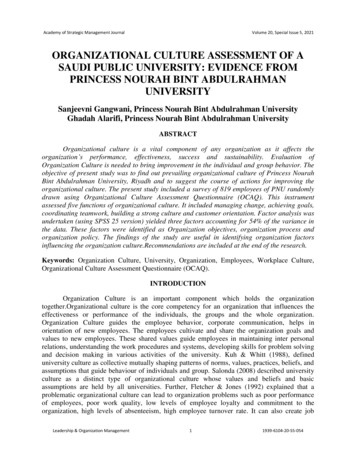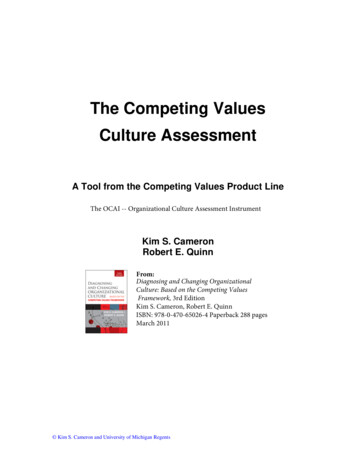
Transcription
The Competing ValuesCulture AssessmentA Tool from the Competing Values Product LineThe OCAI -- Organizational Culture Assessment InstrumentKim S. CameronRobert E. QuinnFrom:Diagnosing and Changing OrganizationalCulture: Based on the Competing ValuesFramework, 3rd EditionKim S. Cameron, Robert E. QuinnISBN: 978-0-470-65026-4 Paperback 288 pagesMarch 2011 Kim S. Cameron and University of Michigan Regents
An Introduction to the Competing Values FrameworkThe Competing Values Framework (CVF) has been recognized as one of the forty mostimportant models in the history of business. It originally emerged from empiricalresearch on what factors make organizations effective. The framework has since beenapplied to a variety of topics related to individual and organizational behavior. It hasbeen the focus of empirical studies for more than 25 years, and it has been employed tohelp thousands of organizations and tens of thousands of managers improve theirperformance. References to a number of books and scholarly publications testing andvalidating the framework are available from the authors.THE COMPETING VALUES FRAMEWORK Kim S. Cameron and University of Michigan Regents
The Four QuadrantsThe Competing Values Framework (CVF) consists of two dimensions—one drawnvertically and the other drawn horizontally—resulting in four quadrants. When studyingthe effectiveness of organizations more than two decades ago, it was discovered thatsome organizations were effective if they demonstrated flexibility and adaptability, butother organizations were effective if they demonstrated stability and control. Similarly,some organizations were effective if they maintained efficient internal processeswhereas others were effective if they maintained competitive external positioning relativeto customers and clients. These differences represent the different ends of twodimensions, and these dimensions constitute the rudiments of the Competing ValuesFramework. Each quadrant in the framework represents a way of being, seeing,managing, and organizing.The Collaborate QuadrantThe Collaborate quadrant represents the kinds of people, purposes, and processes thatgive rise to cooperation and collaboration. People in the Collaborate quadrant tend to becommitted to their community, focusing on shared values and communication. Theirculture is oriented towards involvement and building commitment over time. Companiesdominated by this Collaborate quadrant often seek to be the employer of choice. Drivingpurposes include cohesion and commitment. Leaders build the organization byencouraging trusting relationships and by nurturing a sense of community. Unifiedbehavior produces a strong organizational image in the marketplace. Customers may beconsidered partners in an extended community. The Collaborate quadrant taken to anextreme becomes negative and turns into a permissive, lax environment whereoutcomes and results are under-emphasized.The Create QuadrantThe Create quadrant represents the kinds of people, purposes, and practices that areassociated with creativity, innovation, and vision. Individuals with this perspective tendto be change oriented. The culture that supports their work is characterized byexperimentation, flexibility, and looking forward toward the future. The focus is ongenerating new ideas. These organizations tend to emphasize and supportentrepreneurial activities. Companies in this Create quadrant tend to seek to valuethings that are new. Driving purposes include innovation and growth. They orient theirproducts, services, and ideas toward the future. Managers build the organization bydeveloping a compelling vision and emphasizing new ideas and technologies, flexibility,and adaptability. These organizations can thrive in turbulent environments. The Createquadrant taken to an extreme becomes negative by being constantly chaotic, trying outmultiple new ideas, and under-emphasizing the achievement of predictable outcomesand structure.The Compete QuadrantThe Compete quadrant represents the kinds of people, purposes, and practices that areassociated with aggressive competition and achievement. A focus on achieving resultsleads people to emphasize winners or losers. Individuals with this perspective tend tobe focused on performance and goal achievement. Companies that emphasize thisCompete quadrant tend to emphasize speed and getting results. Driving purposesinclude profits, obtaining market share, revenues, brand equity, and speed of response.Managers build the organization by clarifying objectives and improving the firm’scompetitive position through hard work, competitive strategy, and productivity. Theseorganizations seek to deliver results to stakeholders as quickly as possible. Beating the Kim S. Cameron and University of Michigan Regents
competition is central. The Compete profile taken to an extreme becomes negative bygiving rise to self-interests and conflict and by neglecting the more humane peopleissues.The Control QuadrantThe Control quadrant represents the kinds of people, purposes, and practices that giverise to predicable, dependable performance. People in organizations dominated by theControl quadrant tend to be systematic, careful, and practical. The culture emphasizesplanning, efficient systems and processes, and enforcing compliance. Companies thatemphasize the Control quadrant tend to keep things running smoothly and efficiently.Driving purposes include obtaining high quality or optimization, sometimes expressed aspredictability or minimizing variation and errors. Managers build the organization byoptimizing processes, cutting costs, and establishing policies and procedures. Clear roledefinitions are important. These organizations tend to elaborate or extend existingproducts and services with minor variations. The Control quadrant taken to an extremebecomes negative by leading to red tape, languishing bureaucracy, and organizationalstagnation.An advantage of the Competing Values Framework is that it is based on a welldeveloped theoretical and empirical foundation. A great deal of research has beenproduced to validate the CVF and its applications. It is consistent, for example, with thepsychology of Jung, the sociology of Parsons, the philosophy of Wilber, and the brainphysiology of Lawrence. Individuals taking the assessments, as well as organizationsreceiving data on their own attributes, can link their results to other well-developedelements of improvement.Most importantly, the empirical research conducted by scholars in hundreds oforganizations, coupled with the hundreds of interventions in real organizations that haveutilized the Competing Values Framework, provide a rich array of guidelines andprescriptions for how to improve individual and organizational performance. These arenot merely conveniently created instruments. They are, rather, an integrated array ofassessment devices aimed to help enable and enhance consistent and comprehensiveimprovement. Kim S. Cameron and University of Michigan Regents
THE COMPETING VALUES CULTURE ASSESSMENTWhy should I use the Competing Values Culture Assessment?The purpose of this assessment is to diagnose your organization’s current and desiredculture. Unfortunately, most of us are not even aware of our organization’s cultureinasmuch as culture represents “just the way things are around here.” Culture is thesum of the collective assumptions, expectations, and values that reflect explicit andimplicit rules in the organization. Until challenged or violated, most people are not evenaware that these assumptions and rules exist (such as speaking English or being polite).As a result, it is very difficult to intelligently discuss culture, not to mention try to changeit. We learn about the culture of our organization through socialization processes,interactions under uncertain conditions—when we mostly rely on core habits and themost well-learned responses—and by contagion (or unconscious mimicking). Much ofthat learning, however, is not systematic or conscious.Understanding organizational culture is important because it is the single largest factorthat inhibits organizational improvement and change. Research is clear that healthycultures enhance success whereas unhealthy cultures inhibit success, but in order totake advantage of the power of organizational culture, it must be adequately measured.Research by Cameron and Mora found that 96 percent of the time successful mergersand acquisitions could be accurately predicted based solely on cultural match.Organizational change and improvement, in other words, is markedly affected by culture.A change in organizational culture can occur simply by means of life cycledevelopment—i.e., evolutionary changes—or as a result of a major threat or crisis whendramatic transformations occur. The most productive way to facilitate culture change,however, is through competent leadership and systematic change initiatives. Thisinstrument helps identify the cultural profile of your organization which is a prerequisitefor fostering organizational change and improvement. Because the instrument is basedon the Competing Values Framework, it can help create a common language amongemployees within your organization and give them an easy way to discuss how toeffectively achieve desired results. Kim S. Cameron and University of Michigan Regents
The Competing Values Culture AssessmentThese six questions ask you to identify the way you experience your organization rightnow, and, separately, the way you think it should be in the future if it is to achieve itshighest aspirations. In the survey, “the organization” refers to the organization managedby your boss (or the organization in which you manage).Please rate each of the statements by dividing 100 points between alternatives A, B, C,and D depending on how similar the description is to your firm. (100 would indicate verysimilar and 0 would indicate not at all similar). The total points for each questionmust equal 100. The assessment uses this method to better demonstrate how tradeoffs always exist in organizations and resources—including time and attention—arenever unconstrained. That is, the response scale demonstrates the inherent tradeoffsrequired in any approach to culture change.First, rate how you perceive the organization to be at the present time in the NOWcolumn. Second, rate the organization again in the FUTURE column depending on howyou think your organization must be if it is to accomplish its highest objectives andachieve spectacular success in three to five years.You may divide the 100 points in any way among the four alternatives in each question.Some alternatives may get zero points, for example. Remember that the total must equal100.1.DOMINANT CHARACTERISTICSNOWFUTUREA.The organization is a very personal place. It islike an extended family. People seem to sharea lot of themselves.AAB.The organization is a very dynamic andentrepreneurial place. People are willing tostick their necks out and take risks.BBC.The organization is very results oriented.A major concern is with getting the job done.People are very competitive and achievementoriented.CCD.The organization is a very controlled andstructured place. Formal procedures generallygovern what people do.DD100100Total Kim S. Cameron and University of Michigan Regents
2.ORGANIZATIONAL LEADERSHIPNOWFUTUREA.The leadership in the organization is generallyconsidered to exemplify mentoring, facilitating,or nurturing.AAB.The leadership in the organization is generallyconsidered to exemplify entrepreneurship,innovating, or risk taking.BBC.The leadership in the organization is generallyconsidered to exemplify an aggressive,results-oriented, no-nonsense focus.CCD.The leadership in the organization is generallyconsidered to exemplify coordinating,organizing, or smooth-running efficiency.DD100100Total3.MANAGEMENT OF EMPLOYEESA.The management style in the organization ischaracterized by teamwork, consensus,and participation.AAB.The management style in the organization ischaracterized by individual risk-taking,innovation, freedom, and uniqueness.BBC.The management style in the organization ischaracterized by hard-driving competitiveness,high demands, and achievement.CCD.The management style in the organization ischaracterized by security of employment,conformity, predictability, and stability inrelationships.DD100100Total Kim S. Cameron and University of Michigan Regents
4.ORGANIZATIONAL GLUENOWFUTUREA.The glue that holds the organization togetheris loyalty and mutual trust. Commitment tothis organization runs high.AAB.The glue that holds the organization togetherBis commitment to innovation and development.There is an emphasis on being on the cutting edge.BC.The glue that holds the organization togetheris the emphasis on achievement and goalaccomplishment. Aggressiveness and winningare common themes.CCD.The glue that holds the organization togetheris formal rules and policies. Maintaining asmooth-running organization is important.DD100100Total5.STRATEGIC EMPHASESA.The organization emphasizes humandevelopment. High trust, openness,and participation persists.AAB.The organization emphasizes acquiringnew resources and creating new challenges.Trying new things and prospecting foropportunities are valued.BBC.The organization emphasizes competitiveactions and achievement. Hitting stretchtargets and winning in the marketplace aredominant.CCD.The organization emphasizes permanenceand stability. Efficiency, control and smoothoperations are important.DD100100Total Kim S. Cameron and University of Michigan Regents
6.CRITERIA OF SUCCESSNOWFUTUREA.The organization defines success onthe basis of the development of humanresources, teamwork, employeecommitment, and concern for people.AAB.The organization defines success on thebasis of having the most unique or thenewest products. It is a product leader andinnovator.BBC.The organization defines success on thebasis of winning in the marketplace andoutpacing the competition. Competitivemarket leadership is key.CCD.The organization defines success on thebasis of efficiency. Dependable delivery,smooth scheduling, and low cost productionare critical.DD100100Total Kim S. Cameron and University of Michigan Regents
Computing the Results:Transfer all of your answers from the above questions onto the results key below.Follow the results key until you have the averages for A through D in both the “NOW and“Future” columns of the Assessment.NOWFUTURE1A. 1B. 1C. 1D.1A. 1B. 1C. 1D.2A. 2B. 2C. 2D.2A. 2B. 2C. 2D.3A. 3B. 3C. 3D.3A. 3B. 3C. 3D.4A. 4B. 4C. 4D.4A. 4B. 4C. 4D.5A. 5B. 5C. 5D.5A. 5B. 5C. 5D.6A. 6B. 6C. 6D.6A. 6B. 6C. 6D.Add 1A through 6A to get your total (T) for the A column. Do the same with all thecolumns:A.B.C.D.A.B.C.D.A.B.C.D.Divide Totals by 6 to get your Averages (A):A.B.C.D.A - represents the Collaborate Quadrant(Upper Left Corner)B - represents the Create Quadrant(Upper Right Corner)C - represents the Compete Quadrant(Lower Right Corner)D - represents the Control Quadrant(Lower Left Corner) Kim S. Cameron and University of Michigan Regents
Creating the Visual Results:Creating a visual picture allows for you to think through your results with the CVF moreeffectively. A picture also helps you make more comparisons and capture more trendsthan analyzing numbers alone.Create your visual results by taking your average number in column A of the NOWsection and plotting that point in the Collaborate quadrant. Continue to plot each columnin NOW section until all the quadrants are complete. Then connect the plotted points sothat you have created a kite-like shape (as in the example below).Follow the same steps with the averages from FUTURE section but instead of using foursolid lines use four dotted lines (or solid lines of a different color) to connect the plottednumbers in each quadrant.For Example:CollaborateCreate NOW13 NOW30 FUTURE30 FUTURE32ControlCompete NOW24 NOW33 FUTURE12 FUTURE26 Kim S. Cameron and University of Michigan Regents
Plot Your Own Results Below:CollaborateCreate NOW NOW FUTURE FUTURE ControlCompete NOW NOW FUTURE Kim S. Cameron and University of Michigan Regents FUTURE
Questions Guiding the Culture Change ProcessDiscrepancies & Similarities1. In which quadrants are the discrepancies the greatest between the NOW cultureand the FUTURE culture?2. What changes in organizational culture are implied by your scores?3. To what extent do the discrepancies between NOW and FUTURE suggest asubstantial, transformational change, or do they represent an incremental orevolutionary change?4. In which quadrants are the discrepancies and similarities greatest between yourown ratings of the culture and those of others? How much consistency existsamong colleagues’ ratings?5. In which quadrants do differences exist among the different business units orfunctions in the organization? How much cultural congruence exists amongunits?Planning for ActionAfter reviewing your NOW and FUTURE culture profiles and analyzing the extent towhich congruence exists, follow these steps to begin a culture change process withinyour organization.1. Identify required culture CHANGE. Based on the discrepancies in the cultureplots, what needs to change in the organization? In which quadrants will youwant to increase your emphasis and decrease your emphasis?2. Identify MEANING. In light of your decision to make some changes to achievethe FUTURE culture, answer these two questions about each quadrant:a. What DOES IT MEAN to change in this quadrant?b. What DOESN’T IT MEAN to change in this quadrant?3. Tell Stories. Identify one or two memorable stories or incidents that illustrate theunderlying culture that characterizes your FUTURE culture. What anecdotesymbolizes what you want to become?4. Identify STRATEGIES. Develop two or three specific, actionable strategiesthat are imperative for changing the culture.5.a. What should we do MORE of?b. What should we STOP doing?c. What should we BEGIN anew?6. Identify immediate SMALL WINS. Develop a list of key action steps that youcan implement right away. These will likely be incremental improvements thatcan create immediate momentum for change.7. Identify METRICS, MEASURES, and MILESTONES. Identify the indicators ofsuccess, how they will be assessed, and the time frame in which observableprogress will occur. Kim S. Cameron and University of Michigan Regents
8. Articulate the LEADERSHIP implications. Determine the learning anddevelopment activities that will be needed to develop the leaders you will need toguide the future culture.9. Determine the COMMUNICATION STRATEGY. What symbols, logos, andmechanisms will be used to communicate the new culture? To whom will youcommunicate and how often? Kim S. Cameron and University of Michigan Regents
Organizational change and improvement, in other words, is markedly affected by culture. A change in organizational culture can occur simply by means of life cycle development—i.e., evolutionary changes—or as a result of a major threat or crisis when dramatic transformations occur. The most productive way to facilitate culture change,
